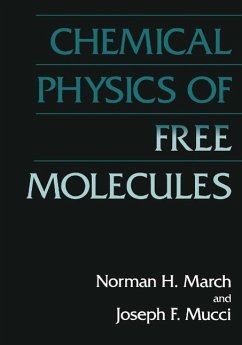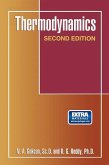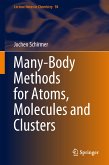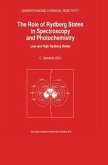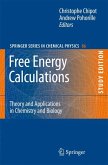73,95 €
73,95 €
inkl. MwSt.
Sofort per Download lieferbar

37 °P sammeln
73,95 €
Als Download kaufen

73,95 €
inkl. MwSt.
Sofort per Download lieferbar

37 °P sammeln
Jetzt verschenken
Alle Infos zum eBook verschenken
73,95 €
inkl. MwSt.
Sofort per Download lieferbar
Alle Infos zum eBook verschenken

37 °P sammeln
- Format: PDF
- Merkliste
- Auf die Merkliste
- Bewerten Bewerten
- Teilen
- Produkt teilen
- Produkterinnerung
- Produkterinnerung

Bitte loggen Sie sich zunächst in Ihr Kundenkonto ein oder registrieren Sie sich bei
bücher.de, um das eBook-Abo tolino select nutzen zu können.
Hier können Sie sich einloggen
Hier können Sie sich einloggen
Sie sind bereits eingeloggt. Klicken Sie auf 2. tolino select Abo, um fortzufahren.

Bitte loggen Sie sich zunächst in Ihr Kundenkonto ein oder registrieren Sie sich bei bücher.de, um das eBook-Abo tolino select nutzen zu können.
In this introductory chemical physics textbook, the authors discuss the interactions, bonding, electron density, and experimental techniques of free molecules, and apply spectroscopic methods to determine molecular parameters, dynamics, and chemical reactions.
- Geräte: PC
- ohne Kopierschutz
- eBook Hilfe
- Größe: 31.85MB
Andere Kunden interessierten sich auch für
![Electron, Spin and Momentum Densities and Chemical Reactivity (eBook, PDF) Electron, Spin and Momentum Densities and Chemical Reactivity (eBook, PDF)]() Electron, Spin and Momentum Densities and Chemical Reactivity (eBook, PDF)113,95 €
Electron, Spin and Momentum Densities and Chemical Reactivity (eBook, PDF)113,95 €![Metallized Plastics 1 (eBook, PDF) Metallized Plastics 1 (eBook, PDF)]() Metallized Plastics 1 (eBook, PDF)73,95 €
Metallized Plastics 1 (eBook, PDF)73,95 €![Thermodynamics (eBook, PDF) Thermodynamics (eBook, PDF)]() N. A. GokcenThermodynamics (eBook, PDF)113,95 €
N. A. GokcenThermodynamics (eBook, PDF)113,95 €![Many-Body Methods for Atoms, Molecules and Clusters (eBook, PDF) Many-Body Methods for Atoms, Molecules and Clusters (eBook, PDF)]() Jochen SchirmerMany-Body Methods for Atoms, Molecules and Clusters (eBook, PDF)89,95 €
Jochen SchirmerMany-Body Methods for Atoms, Molecules and Clusters (eBook, PDF)89,95 €![The Role of Rydberg States in Spectroscopy and Photochemistry (eBook, PDF) The Role of Rydberg States in Spectroscopy and Photochemistry (eBook, PDF)]() The Role of Rydberg States in Spectroscopy and Photochemistry (eBook, PDF)105,95 €
The Role of Rydberg States in Spectroscopy and Photochemistry (eBook, PDF)105,95 €![Free Energy Calculations (eBook, PDF) Free Energy Calculations (eBook, PDF)]() Free Energy Calculations (eBook, PDF)274,95 €
Free Energy Calculations (eBook, PDF)274,95 €![The Chemical Bond (eBook, PDF) The Chemical Bond (eBook, PDF)]() Tadamasa ShidaThe Chemical Bond (eBook, PDF)113,95 €
Tadamasa ShidaThe Chemical Bond (eBook, PDF)113,95 €-
-
-
In this introductory chemical physics textbook, the authors discuss the interactions, bonding, electron density, and experimental techniques of free molecules, and apply spectroscopic methods to determine molecular parameters, dynamics, and chemical reactions.
Dieser Download kann aus rechtlichen Gründen nur mit Rechnungsadresse in A, B, BG, CY, CZ, D, DK, EW, E, FIN, F, GR, HR, H, IRL, I, LT, L, LR, M, NL, PL, P, R, S, SLO, SK ausgeliefert werden.
Produktdetails
- Produktdetails
- Verlag: Springer US
- Seitenzahl: 393
- Erscheinungstermin: 29. Juni 2013
- Englisch
- ISBN-13: 9781475796469
- Artikelnr.: 44184799
- Verlag: Springer US
- Seitenzahl: 393
- Erscheinungstermin: 29. Juni 2013
- Englisch
- ISBN-13: 9781475796469
- Artikelnr.: 44184799
- Herstellerkennzeichnung Die Herstellerinformationen sind derzeit nicht verfügbar.
One Chemical Concepts and Experimental Techniques.- Two The Nature of Bonding in Diatoms.- Three Molecular Interactions.- Four Electron Density Description of Molecules.- Five Molecular Parameters Determined by Spectroscopic Methods.- Six Molecular Orbital Methods and Polyatomic Molecules.- Seven Chemical Reactions, Dynamics, and Laser Spectroscopy.- A1.1. Wave Functions for the Hydrogen Atom.- A1.2. The Periodic Table and Atomic Ground States.- A1.3. Total Energies of Heavy Atomic Ions-Coulomb Field Model.- A1.4. Orthogonality of Solutions of the Schrödinger Equation.- A2.1. Variation Principle.- A2.3. Born-Oppenheimer Approximation.- A2.4. Slater- and Gaussian-Type Orbitals.- A2.6. Virial and Hellmann-Feynman Theorems.- A3.1. Topics Relevant to the Treatment of Intermolecular Forces.- A3.2. Bibliography for Further Study of Intermolecular Forces.- A4.1. The Correspondence between Cells in Phase Space and Quantum-Mechanical Energy Levels.- A4.2. The Kinetic Energy Density of an Inhomogeneous Electron Gas.- A4.3. The Chemical Potential, Teller's Theorem, and Scaling of Energies of Homonuclear Diatoms.- A4.4. The Self-Consistent Field in the Helium Atom.- A4.5. The Self-Consistent Field Treatment of Binding Energies of Heavy Positive Atomic Ions.- A4.6. The Hartree-Fock Self-Consistent Field Method.- A4.7. The Dirac-Slater Exchange Energy and Existence of a One-Body Potential Including Both Exchange and Correlation.- A4.8. Proof that the Ground-State Energy of a Molecule Is Uniquely Determined by the Electron Density.- A4.9. Modeling of the Chemical Potential in Hydrogen Halides and Mixed Halides.- A4.10. X-Ray Scattering by Neon-Like Molecules.- A4.11. Two-Center Calculations from the Thomas-Fermi Theory.- A5.1. Rotational Energy Levels of Some Simple Classes ofMolecules: The Symmetric Rotor.- A5.2. The Rotational Partition Function in Relation to Spectroscopic Intensities.- A5.3. Normal Modes of Vibration of Molecules.- A5.4. The Franck-Condon Principle.- A5.5. Time-Dependent Perturbation Theory and Selection Rules for Electric Dipole Transitions in Atoms.- A5.6. Spin-Orbit Coupling.- A5.7. Dirac's Relativistic Wave Equation for One Electron.- A5.8. Relativistic Electron Density Theory for Molecules Composed of Heavy Atoms.- A6.1. The Jahn-Teller Effect.- A6.2. Koopmans' Theorem and Its Use in Interpreting Photoelectron Spectra.- A7.1. Symmetry Arguments for Electrocyclic Reactions.- A7.2. Chemical Reactions: Arrhenius' Empirical Work, the Collision Theory, and the Absolute Rate or Transition State Theory.- Advanced Problems.- AI. Some Advanced Aspects of Quantum-Mechanical Perturbation Theory.- AII. The Formation of Acetylene from Two CH Fragments.- AIII. MacDonald's Theorem.- AIV. Spectroscopic Nomenclature.- AV. The Wentzel-Kramers-Brillouin Semiclassical Method for Calculating Eigenvalues for Central Fields.- AVI. Electron Correlation in the Helium Atom and the Slow Convergence of Configuration Interaction.- Further Problems.- References.
One Chemical Concepts and Experimental Techniques.- Two The Nature of Bonding in Diatoms.- Three Molecular Interactions.- Four Electron Density Description of Molecules.- Five Molecular Parameters Determined by Spectroscopic Methods.- Six Molecular Orbital Methods and Polyatomic Molecules.- Seven Chemical Reactions, Dynamics, and Laser Spectroscopy.- A1.1. Wave Functions for the Hydrogen Atom.- A1.2. The Periodic Table and Atomic Ground States.- A1.3. Total Energies of Heavy Atomic Ions-Coulomb Field Model.- A1.4. Orthogonality of Solutions of the Schrödinger Equation.- A2.1. Variation Principle.- A2.3. Born-Oppenheimer Approximation.- A2.4. Slater- and Gaussian-Type Orbitals.- A2.6. Virial and Hellmann-Feynman Theorems.- A3.1. Topics Relevant to the Treatment of Intermolecular Forces.- A3.2. Bibliography for Further Study of Intermolecular Forces.- A4.1. The Correspondence between Cells in Phase Space and Quantum-Mechanical Energy Levels.- A4.2. The Kinetic Energy Density of an Inhomogeneous Electron Gas.- A4.3. The Chemical Potential, Teller's Theorem, and Scaling of Energies of Homonuclear Diatoms.- A4.4. The Self-Consistent Field in the Helium Atom.- A4.5. The Self-Consistent Field Treatment of Binding Energies of Heavy Positive Atomic Ions.- A4.6. The Hartree-Fock Self-Consistent Field Method.- A4.7. The Dirac-Slater Exchange Energy and Existence of a One-Body Potential Including Both Exchange and Correlation.- A4.8. Proof that the Ground-State Energy of a Molecule Is Uniquely Determined by the Electron Density.- A4.9. Modeling of the Chemical Potential in Hydrogen Halides and Mixed Halides.- A4.10. X-Ray Scattering by Neon-Like Molecules.- A4.11. Two-Center Calculations from the Thomas-Fermi Theory.- A5.1. Rotational Energy Levels of Some Simple Classes ofMolecules: The Symmetric Rotor.- A5.2. The Rotational Partition Function in Relation to Spectroscopic Intensities.- A5.3. Normal Modes of Vibration of Molecules.- A5.4. The Franck-Condon Principle.- A5.5. Time-Dependent Perturbation Theory and Selection Rules for Electric Dipole Transitions in Atoms.- A5.6. Spin-Orbit Coupling.- A5.7. Dirac's Relativistic Wave Equation for One Electron.- A5.8. Relativistic Electron Density Theory for Molecules Composed of Heavy Atoms.- A6.1. The Jahn-Teller Effect.- A6.2. Koopmans' Theorem and Its Use in Interpreting Photoelectron Spectra.- A7.1. Symmetry Arguments for Electrocyclic Reactions.- A7.2. Chemical Reactions: Arrhenius' Empirical Work, the Collision Theory, and the Absolute Rate or Transition State Theory.- Advanced Problems.- AI. Some Advanced Aspects of Quantum-Mechanical Perturbation Theory.- AII. The Formation of Acetylene from Two CH Fragments.- AIII. MacDonald's Theorem.- AIV. Spectroscopic Nomenclature.- AV. The Wentzel-Kramers-Brillouin Semiclassical Method for Calculating Eigenvalues for Central Fields.- AVI. Electron Correlation in the Helium Atom and the Slow Convergence of Configuration Interaction.- Further Problems.- References.
